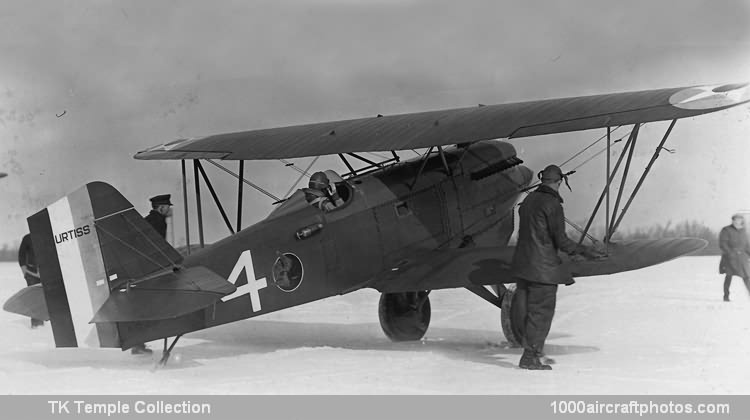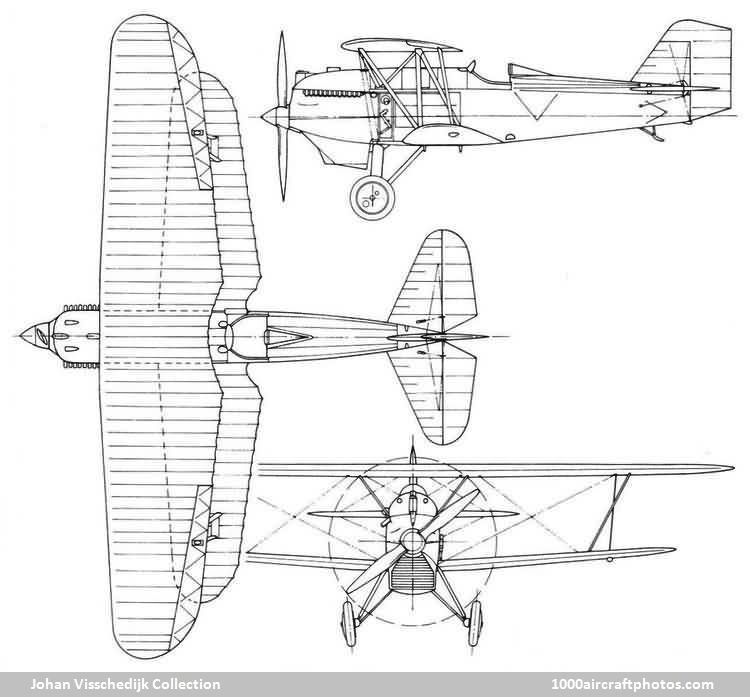09/30/2012. Remarks by Johan Visschedijk: "The P-1s were the first tapered-wing Hawks in production and established some milestones in Army aviation. From 1918 and through to the P-1Bs, standard coloring for US combat aircraft was olive drab overall; but, starting with P-1Cs, wing and tail coloring was changed to high visibility chrome yellow. In July 1926, the Army Air Service became the Army Air Corps, a notable change introduced late in 1926, but not used universally until the end of 1927, was the new Army horizontal tail striping. The following versions were built.
P-1 (Model 34A). Fifteen production versions of the XPW-8B were ordered, with USAAS serials 25-410 to 25-424. They were fitted with the 420 hp Curtiss D-12 engine but had provision for alternative installation of the slightly larger 500 hp Curtiss V-1400. Fuel capacity could be increased by installation of a 55 gal (208 l) auxiliary fuel tank under the belly. Deliveries started in August 1925 but the last five P-1s were completed as P-2s. The first P-1 was fitted with an experimental inverted Allison air-cooled variant of the Liberty engine in 1926, but did not, as was customary, receive a revised designation. In 1930 it became the XP-17 when fitted with still another experimental engine change.
P-1A (Model 34G). Improved P-1s of which 25 (s/n 26-276 to 26-300) were ordered in September 1925, with deliveries beginning the following April. Engines were improved 422 hp D-12Cs and the fuselage was lengthened 3 in (7.62 cm). 26-296 was converted to the XAT-4 and 26-300 was delivered as the first XP-3A before becoming XP-21 and XP-21A. Three additional P-1As resulted from the installation of D-12 engines in P-2s (s/n 25-421, 25-422, and 25-424).
XP-1A. Not a prototype, but the P-1A with s/n 26-280 which was diverted to test work.
P-1B (Model 34I). Improved Hawks of which 25 (s/n 27-63 to 27-87) were ordered on August 17, 1926, deliveries began in December 1926.
XP-1B. Not prototypes, but the P-1Bs with s/n 27-71 and 27-73 which were used for test work at Wright Field, the latter had machine guns in the wings.
P-1C (Model 34O). Improved versions of which 33 (s/n 29-227 to 29-259) were ordered in October 1928, these had larger wheels fitted with brakes and the last two had hydraulic instead of rubber-block shock absorbers. The last P-1C was completed as XP-6B.
XP-1C. Again, not a prototype, but the P-1C with s/n 29-238 that was assigned to Wright Field with the Project Number "XP-579", and was used for experimental work, including a new radiator design.
P-1D. Refitted with D-12 engines, 35 AT-4 Advanced Trainers (s/n 27-88 to 27-97 and 27-213 to 27-237) became P-1Ds and were reclassified as Pursuits.
P-1E. All five AT-5s (s/n 27-238 to 27-242) became P-1E when fitted with D-12 engines, although carrying Pursuit designations, they were used only as trainers.
P-1F. All 31 AT-5As (s/n 28-42 to 28-72) became P-1F when fitted with D-12 engines. One additional P-1F resulted from installation of a D-12 in the second XP-21 (s/n 28-189), formerly the second XP-3A."

